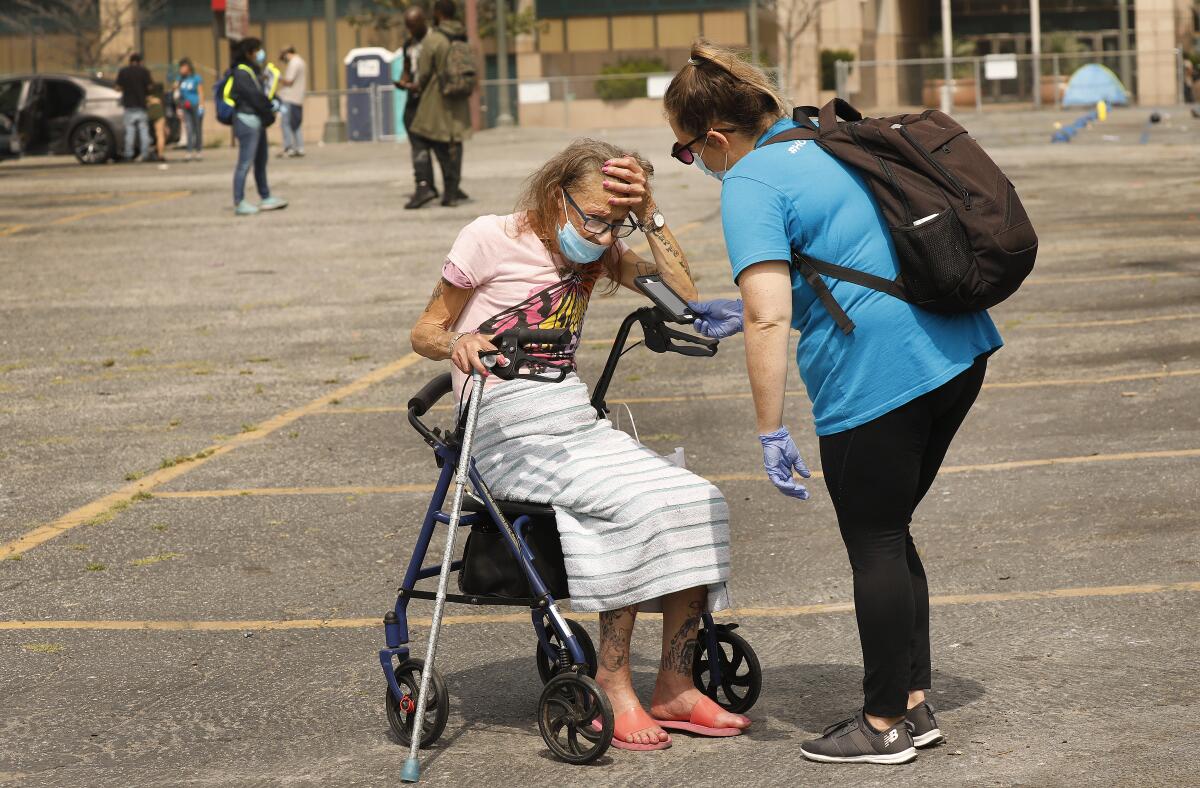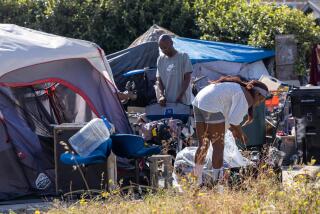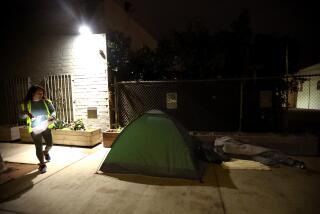Homeless people were largely spared coronavirus’ first wave. But they need help to stay alive

- Share via
One of the greatest fears about the pandemic was that COVID-19 would run rampant through the homeless population and kill hundreds of people. Already burdened with medical problems and physically beaten down by the hardships of living outside, the most vulnerable homeless people would seem to be no match for an invasive virus that has attacked young and old, killing some 186,000 in the U.S., more than 13,000 of those in California.
But here’s some surprising news: Homeless people appear to have survived this scourge — so far. According to the latest L.A. County data, there have been 1,589 cases and 41 deaths among an estimated 66,000 homeless individuals. Some public health researchers had predicted up to 10 times as many deaths.
To be clear, homeless people are still dying in alarming numbers — the county tallied 865 as of Aug. 28, a death toll almost 30% higher than in the same period last year. And it’s not simply because there are more homeless people.
County researchers need to examine those deaths to find out what role, if any, COVID-19 played. Heidi Behforouz, the medical director of the county’s Housing for Health program, is concerned that the deaths may be related to a pandemic-caused disruption in care and support systems that homeless people rely on. Or perhaps drug and alcohol usage got worse among homeless people stressed over the pandemic. These are all factors to be evaluated.
But something did go right here. The county moved vulnerable homeless people off the streets and into about 4,000 hotel and motel rooms. The city of Los Angeles took temporarily shuttered recreation centers and turned them into shelters providing about 1,000 beds at their peak. And the city stopped enforcing anti-camping regulations and allowed people to keep their tents up during the day, in keeping with the Centers for Disease Control and Prevention’s recommendation that people living in encampments remain in place if individual housing is not available.
(Besides, with 544 cases reported at 106 shelters as of late August, can you blame homeless people for wanting to stay in their tents?)
Hundreds of hand-washing stations and portable toilets — all desperately needed before the pandemic — were put up at encampments across the city. County outreach workers have done 20,000 health checks on encampments since June. The Department of Health Services alone has administered nearly 30,000 coronavirus tests to more than 21,000 homeless people across the county. (That doesn’t count the testing that homeless people have gotten in clinics, hospitals and other locations.)
All that effort was commendable and probably life-saving. But 72% of the L.A. County homeless population live in tents, vehicles and sleeping bags. Only 28% spend the night in shelters.
It’s exquisitely ironic that the cruel circumstances under which most homeless people live may have kept them somewhat safer. Being inside with people appears to put you more at risk of getting COVID than being outside with people.
And no one gets more social distance than homeless people, who were routinely avoided on streets long before public health officials told everyone to stay six feet apart. It’s unlikely that homeless people got invited to dinner parties, weddings and other super-spreader events that left guests sick with COVID-19.
Now, let’s keep homeless people from succumbing at a higher rate to a virus that is still a public health crisis. The goal continues to be permanent housing. And it’s never been more urgent. But in the absence of that, the alternative should not be big group shelters — even with more space between beds. Nothing has changed in the CDC guidance. Homeless people in encampments should be left in encampments unless they are provided with individual housing — whether that’s an apartment, a private room or a so-called tiny house.
Unfortunately, city officials and police officers have renewed efforts to displace encampments in spite of the public health risks. This includes the L.A. City Council’s decision to resume the deep cleanings that dislodge homeless people and their tents, and the Los Angeles Police Department’s decision to repeat the ticketing of homeless people who do not move off the sand at Venice Beach.
Nobody wants people living in tents anywhere, including on the beach. And officials insist that the efforts are done humanely — for example, by providing showers and water near the clean-ups. But we’re still in the midst of a deadly pandemic, and it’s not the time to send homeless people wandering in search of a new place to stay.
More to Read
A cure for the common opinion
Get thought-provoking perspectives with our weekly newsletter.
You may occasionally receive promotional content from the Los Angeles Times.









